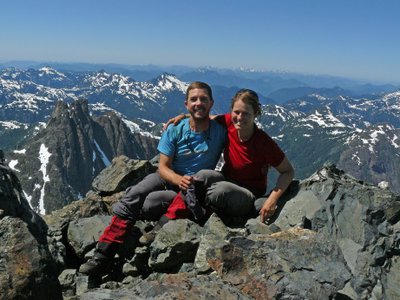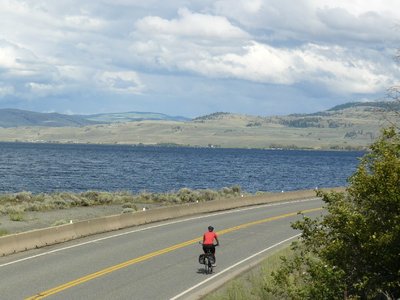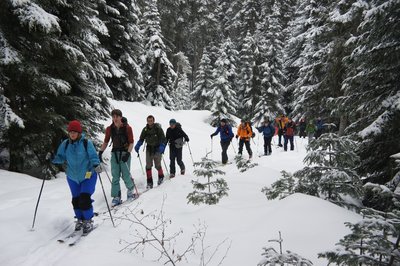
Elk-Westmin Traverse: Serendipity Strikes Twice in Strathcona

I love those funny coincidences that make so much sense and yet are so surprising. On the first day of this eight day trip, while hiking up the Elk River Trail, we met a group that had turned around from a similar route to the one we had planned. They spoke of huge amounts of snow and a narrow gully with truck sized boulders, partially covered with snow, making for treacherous footing, where any moment one might fall into the creek. They had roped up, which sounded weird to me. The guy in the front noticed a piece of paper I was referring to, and said “that’s my trip report!”. It turns out he had been there several years before and had written a trip report and posted it on Bivouac. First strike for serendipity. After gathering more information, we marched on, unsure of what this meant for us – would we manage to get through? We decided to continue, and if it was really bad we could turn around after a few days.
The trail up the Elk River is lined with impressive old growth trees, and makes for an interesting forest hike. After setting up camp at the gravel bar campground, we hiked up to Landslide Lake. This is an awe inspiring place – the lake is located right below the huge face of Mt. Colonel Foster. Apparently, in 1946 a part of Mt. Colonel Foster fell into this lake, leaving a wide swatch visible to this day, and giving the lake its name.
The next day (day 2) we left the maintained trail and hiked up a route with some sparse flagging. We passed a few rough sections through slide debris and an alder tunnel or two. Then I heard a noise ahead of us in the bushes, and saw a bear climb up a tree as swiftly as an acrobat in a circus. The bear was snorting and mumbling to itself, but didn’t mean us any harm, so we continued on our way. Finally we reached the snow we had been warned about, but it was actually a delight! So much easier to hike directly up the snow that covered the creek, all the way to Elk Pass. To this day I’m not sure what that other group thought was so dangerous about this section. At the head of the valley we could see the well-named Elkhorn Mountain (for the horn on its side) and the big hulking mass of rock which is Rambler Peak. We watched the sun set and the beautiful golden glow of Golden Hinde, which we intended to climb a few days later. Finally we were in the alpine, and I expected much easier going from there. Little did I know that we’d be going up and down, from the alpine, bushwhacking into the trees and back out, many times over the next week…
The next day (day 3) we bushwhacked down to a flat spot with some picturesque blue and green puddles in the snow. Then more bushwhacking along the shore of an almost perfectly circular lake, following a vague bear track, complete with very fresh bear poop. We had lunch by the lake and I took a very refreshing swim of the “jump in jump out” type. We made our way onto an easy snowy ridge which led to the west summit of Mt. DeVoe, and beautiful views all around. The amount of snow on all the mountains around us made it feel like the end of spring and not mid summer (late July). We reached the col between the two peaks of Mt. DeVoe, which is a rather forlorn place – the col is small and doesn’t afford much of a view. We slept on snow for the first time this trip, but several more snow camping nights were to follow.
From there we headed down (day 4), and back up onto a snowy ridge (there were many). We had a good view of a steep snowy slope that we would have to go up in order to make our way to the south side of the Behinde, the mountain which is behind the Golden Hinde. From where we were, this slope looked impossibly steep, and we both agreed it was out of the question. However, as we got closer I noticed it was getting mellower and mellower. We followed the ridge and then headed down to a densely treed col, which was surprisingly rugged – I could not have identified it as a saddle just by looking. We bushwhacked our way towards the steep slope, to see if perhaps we could do it after all – and we did. After a short break by a huge boulder, that provided a relief from the heat and a refreshingly cool fill up of our bottles, we headed up the steep slope. We could see a large waterfall of raging water that disappeared below the snow that we were climbing up, always a reassuring sign. There was one final steeper slope where it would be inadvisable to fall, and finally the slope eased off and led us to a beautiful tarn, shaped like the peace sign written in turquoise water on white snow.

Over the past day or two we had discussed several times what would happen if one of us had an accident. It didn’t look too good – about three days of hiking and bushwhacking on rough terrain and no obvious trail, before we could even call for help. We tried to forget about it and keep going – after all, in the old days no one had sat phones, SPOT devices or even cellphones. Of course some of those people actually died when they could have been rescued…

Day 5 was the day we climbed Golden Hinde. First we hiked up another snowy ridge (you guessed it), above our peace shaped tarn and a beautiful jumble of dark blue lakes. We were finally getting close. Some more sidehilling on snow, and we ditched our backpacks, and headed straight up steep snow and then rock. From there we picked up the normal route of the SE colouir – there were some cairns and even footprints from the day before. We headed up a steep and narrow colouir where a fall could have been bad, very bad. Maya was worried about the descent. We kept going, and luckily it was already some time after noon and the snow was relatively soft, making for easy step kicking. Finally we reached the summit ridge, and a few more moves to pass some boulders, and we were on the summit of the world! Maybe not quite the world, but the highest summit on Vancouver Island. Only one other group had climbed the peak that year, and it was a guided group that had gone up the day before us.

We enjoyed the summit views, signed the register, and tried to hide from the scorching sun – we were both getting rather brown by this stage. Reversing our route was more scary than the way up – it was Maya’s first time on such steep snow. When we were already close to our packs, Maya took a small slide and fell into a moat, where the snow meets rock, but luckily it was a soft fall, and she just got a few bruises. Once we retrieved our packs we glissaded and ran down to a small tarn and camped right beside it, with a beautiful view of the south side of Golden Hinde. We could see our tracks, and they looked impossibly steep. Perspective is a tricky thing.
On this trip, whenever we found a cairn or a piece of flagging, it was a cause for celebration… We are on route! Even though we didn’t make any serious route finding errors the whole trip, there was still a constant uncertainty in the air. The next day (day 6) we hiked down an easy rocky ridge to the end of Burman Lake, mostly following a trail, and then up the north ridge of Mt. Burman. Looking back, the view was dominated by Golden Hinde and the Behinde, which by now felt as familiar as a pair of good friends. When we arrived to the sub summit of Mt. Burman, we looked up and didn’t see an obvious easy route up the steep rocky face. We decided to try and bypass it from the side – a mistake. We scrambled up on snow and then rock, which got harder and harder. Finally there was a very memorable move where I told Maya to “just go through the tree” – there were no holds, so we just pulled on some branches and hoped for the best. At the top, we were surprised but relieved to find a large group of hikers, the first people we had seen since the first day. They were heading to Golden Hinde, as well. We continued along the ridge, mostly on snow, to the summit of Mt. Burman.

From the summit we descended the east ridge part way, and stopped for the night – we always prefer to camp high if possible, both for the views and the lack of bugs. By this stage we had gotten used to wet boots, and I mean completely soaked. Hiking on moist snow day in and day out was taking its toll. At our lunch spot and in the evening I’d do a little ceremony of taking off my shoes, pouring out the puddles of water, and wringing out my socks. My feet looked like a dead man’s feet – the skin all white, and peeling all over, to the point where I had to cut off large pieces of loose skin. Thankfully it was not painful at all, perhaps due to a recent trip to the Valhallas that also involved wet feet for a few days, which might have prepared my feet for this ordeal.
From our camp we had a good view of Phillips Ridge – the final ridge we would have to traverse before hiking out. It still looked like a long way. When I planned the trip, I said it would be a 7 day trip, since that seemed like enough time, even allowing for an additional side trip or two to scramble peaks in the area, or for bad weather. In the end, we were slowed down by the huge amounts of snow and route finding, and it was now obvious to us that to actually finish in that amount of time we’d have to really push it. Since we were in no hurry, and Maya had thankfully convinced me to bring one additional dinner, we decided to extend the trip by one day or at least half a day. This allowed us to continue our trip in a relatively relaxed fashion instead of rushing it. The trip in general was a delight, with blue skies and warm sun every day, panoramic views in all directions and a true wilderness feel. However, we were both somewhat exhausted by this stage, both physically and mentally. At least we were eating well – I had made a serious dehydrating effort before the trip, so we had such delicacies to look forward to such as spaghetti bolognaise, and pasta with red sauce, tuna and olives.
The next day (day 7) we hiked and bushwhacked down to Carter Lake, which was much easier than anticipated. There was a beautiful reflection of Golden Hinde, and the snow on the lake looked like small clouds cradling the summit. At the end of the lake we found a good trail, which we happily followed downstream for a while, before crossing the creek and heading up to Phillips Ridge. The trail disappeared below hard snow part way up the ridge, and we found it every now and then after that. Once on the ridge we went up and down a few bumps, with some beautiful views of Schjelderup and Carter Lakes, which had been half covered with snow just two days before, as we had seen them from the summit of Golden Hinde. Every now and then we found the footsteps of the group we had met on Mt. Burman, but for the most part their prints had already disappeared. On the way up to one bump we saw a Ptarmigan, that elusive and rare bird that lives in the alpine. We traversed below one last bump, and then found a camping spot right at the end of the ridge, at treeline. One advantage of snow was that we could just bury our food (and all things that smell like food) in the snow and retrieve them the next day, instead of rigging a laborious tree hang (the usual procedure).

I had expected to find an easy trail from the ridge to Arnica Lake (day 8), but it was all covered in snow, so after trying to follow a very intermittent trail we finally gave up on the trail and just followed the compass, directly down to the lake. At this stage we were looking out for people that might be able to take us back to the highway or even better – our car, but there were none. In general on the trip, we had seen very few people. Another thing which we had seen very little of were clouds. On day 6 one of us pointed to the sky excitedly, noting the the first clouds we had seen on the trip, and they were tiny.
Once we started descending from the lake, there were some beautiful flower meadows, and then a long, somewhat boring trail. The switchbacks were so long and mellow, that often the trail seemed to just be traversing and not even taking us down at all. Eventually we started seeing views of the huge and ugly scar that is the Westmin mine. Strathcona Park has gone through some changes in the amount of protection it gets – it now has a highway, and a working mine right in the park, and over the years logging was even allowed in some parts of the park. Finally we were down at the trail head and noticed a couple just getting into their car to leave. We hurried over to talk to them, and yes they didn’t mind taking us. After some more chatting, we discovered that they were the same people who had climbed Golden Hinde the day before us! Serendipity strikes again. They even took us right to the car, even though it took them out of their way – we could not have coordinated a ride in advance any better than that!



